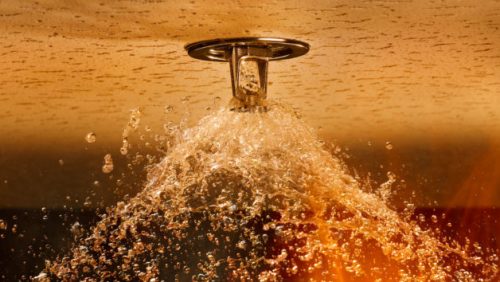How to Install Fire Sprinklers: The Fastest Way to Put Out a Fire
How to Install Fire Sprinklers: The Fastest Way to Put Out a Fire

What puts out a fire? If you said firefighters, you aren’t exactly wrong, but it could take a while for your rescuers to arrive—which may explain why house fires kill more than 2,500 people each year and damage $7 billion in property. There’s actually a far more effective way to put out fires, and it involves learning how to properly install fire sprinklers.
Never heard of home fire sprinklers? That’s understandable, considering only 5% of residences have them installed. But here’s why you should consider them: Home sprinklers can control and extinguish a fire far faster than it would take for the fire brigade to show up at your door. In fact, according to the National Fire Protection Association, the risk of dying in a house fire decreases by 80% in homes where sprinklers are installed.
“Home fire sprinklers are one of the best ways to protect you and your family in the event of a blaze,” says Lorraine Carli, vice president of outreach and advocacy for the NFPA. But “people don’t know about them. As more folks are educated about the life-saving value, we are seeing more homes including them.”
If you think you’d like your home to be one of them, read on for what you need to know.
How much do fire sprinklers cost?
The best and cheapest time to install a fire sprinkler system is when you’re building a new home or doing a major renovation. That’s when walls and ceilings are still open, and it’s easy to add the water supply and install the sprinklers. According to CostHelper, installing fire sprinklers then costs $1.61 per square foot, or $3,542 for a 2,200-square-foot home.
Installation becomes dicey and pricey when you retrofit an entire house with sprinklers. That’s when you’ll have to cut holes in walls and ceilings, run pipes, then patch and paint the walls again, which ranges from $2,000 to $16,000 depending on the size of your house and if/how long a community has had sprinkler ordinances in place. The longer a community requires sprinklers, the more competition grows and lowers prices.
How home sprinkler systems work
Fire sprinklers really are low-tech: They start with pipes filled with water and pressure, similar to your other plumbing pipes, which run behind walls and in ceilings. If your current plumbing has enough pressure—at least 100 PSI—installers can tap into it; if not, you’ll have to spring for a pump and a 300-gallon holding tank that can feed a sprinkler system for about 10 minutes.
Every few feet, the sprinkler pipes have connectors that let out water. Each has a heat-sensitive trigger, most often a glass tube filled with liquid or solder link. During a fire, the air heats, and once the temperature reaches 155 degrees Fahrenheit, the trigger glass shatters or the solder melts, releasing water that sprays out the fire.
In the movies, a whole house of sprinklers explodes water at once. But in reality, each sprinkler is activated individually. The Home Fire Sprinkler Coalition says that 90% of fires are stopped by a single sprinkler.
How to retrofit a home for fire sprinklers
Retrofitting a house with a fire sprinkler is not a weekend DIY project for an amateur. You’ll need an experienced sprinkler company to do the work.
- Work with the sprinkler contractor to form a plan of where you want the devices and how you’ll get the water to them. Part of this process is figuring out how to install the necessary sprinklers with the least amount of disruption to walls, studs, and floor joists. Contractors will take advantage of closets, where they can run a pipe outside the wall, or ceiling molding that can hide the pipes running behind them. At the end of the planning process, you’ll have a set of blueprints that show where each pipe will live in your home.
- Contractors start opening walls and drilling through studs and joists to accommodate pipes they’ll install up and across walls.
- When the pipes and connectors are installed, the contractor will repair wall holes, then install the sprinkler head, usually covered with a cap that easily blows away in case of fire.
Sprinkler maintenance
Take care not to displace sprinklers when you’re dusting, and if you paint, cover them with a cup so you don’t splatter them. If you install sprinklers in a basement with low ceilings, it’s a good idea to cover each sprinkler with an open cage to protect them from unwitting blows—these things are not indestructible. And, it’s always smart to eyeball sprinklers to make sure they haven’t been covered by furniture.
Periodically verify that water shut-off valves remain open and the storage tank, if you’re using one, is full. And, annually perform a flow test through the clearly labeled flow-test value, which discharges to the outside.
To test it, slowly open the valve. You’re looking for pressurized water to run out, which shows that your tank and pump are working. If your sprinkler system is connected to your alarm system, the test will trigger the alarm. It’s a good idea to warn your alarm company you are running the test, so it doesn’t dispatch fire fighters on a false call.



